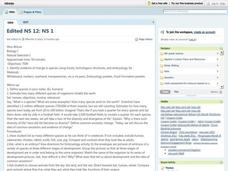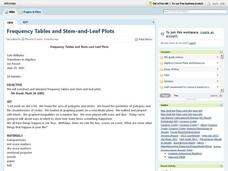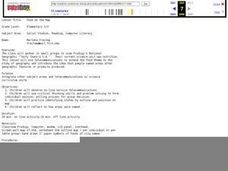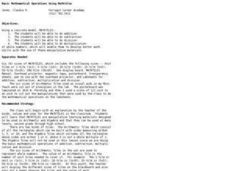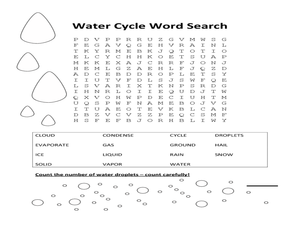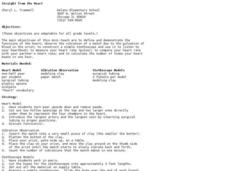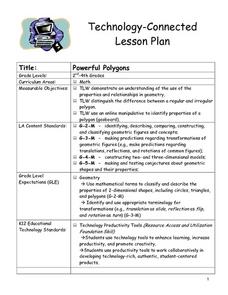Mathematics Vision Project
Quadratic Functions
Inquiry-based learning and investigations form the basis of a deep understanding of quadratic functions in a very thorough unit plan. Learners develop recursive and closed methods for representing real-life situations,...
Curated OER
Teaching with Collections
Students examine collections. In these real-world collections lessons, students examine and describe buttons and shells. Students will then sort, classify, and graph items according to various indicated descriptors.
Curated OER
Introduction to Calculus
Twelfth graders discuss attitude necessary to be successful in calculus. For this calculus lesson, 12th graders review famous quotes about success to help them get motivated to learn and be successful in the classroom. This assignment...
TryEngineering
Data Representation: Millions of Colors
How many colors do you know? The lesson teaches scholars how digital devices use binary and hexadecimal representations to store colors. They learn how millions of colors are available on these devices.
Curated OER
Populations
Take your ecology aces out in the field to practice population counts and model the benefits of camouflage. Though not particularly exciting, these activites and the assessments that are also included are practical and applicable to your...
Curated OER
Combining Elements to Form a Compound
Learners explore elements and compounds. In this instructional activity about elements and compounds, students will do an experiment. Learners work in groups of 2-3 as they complete two separate activities. Students understand how two...
Curated OER
Human Embryonic Stem Cells
Students use the Internet to discover information about human embryonic stem cells from the National Institutes of Health. They examine different sides of the debate to use or not to use stem cells. They can also listen to speeches given...
Curated OER
Division for Third Graders
Explore division and measurement relationships with your math class. They will work in pairs to measure and cut a piece of cord 100 centimeters or longer. Then they cut off equal pieces of less than 10 centimeters until all the cord is...
Curated OER
Natural Selection
Students estimate how many different species of organisms inhabit the Earth. In groups, they match the pictures of embryos at the different stages of development. They compare and contrast animals from the sky, land, and water and...
Curated OER
Natural Selection Day 1
Young scholars define the concept of classification. In groups, they categorize a series of objects into categories they identify. As a class, they participate in a variety of activities to examine the concept of natural selection. To...
Curated OER
The Kingdoms
High schoolers review the various categories in taxonomy. In groups, they identify the characteristics of each kingdom and compare and contrast them. They define the terms binomial nomenclature and morphology. To end the lesson, they...
Curated OER
Frequency Tables and Stem-and-Leaf Plots
Students are introduced to the function of frequency tables and stem and leaf plots. In groups, they determine the frequency of their teacher coughing, ringing a bell or raising their hand. To end the lesson, they determine frequency...
Curated OER
Finding Volume
Sixth graders develop a rule for finding the volume of rectangular solids using colored cubes. They investigate the properties of solid figures and find the volume of an object by counting units. Students fill spaces with standard-sized...
Curated OER
Food on the Map
Students work together to examine the tastiest towns in the United States. After discovering the names of the equipment, they identify the seven continents. They take a survey and locate the cities and states of the foods mentioned.
Curated OER
Basic Mathematical Operations Using Math Tiles
Practice addition, subtraction, multiplication, and division using tiles as manipulatives. In this math operations lesson, young learners choose the appropriate sized tiles, arrange them according to directions given by the teacher, and...
Curated OER
The Great Melting Race
Students show their knowledge by choosing the correct answer about solids, liquids and gases. Students also write short answer responses to questions about experiments they have done.
Curated OER
Urban Effects on Inshore Plankton
Students investigate the effects of urban pollution on plankton. In this plankton and pollution lesson plan, students use samples of plankton collected in urban areas to observe the effects of pollution on plankton samples. They...
Curated OER
Dissecting Owl Pellets
Students explore owl pellets. In this animal science lesson, students use owl pellet dissection kits to dissect one owl pellet. Students use a magnifying glass to identify the foods that the owl ate.
Curated OER
Rocks
Students examine and classify various types of rocks. For this rock identification lesson, students complete a KWL chart about rocks and then read Let's Go Rock Collecting. Students go on a walk to collect rocks and then...
Curated OER
Mole Relations
Tenth graders investigate the mole using raisins, sunflower seeds and M&Ms candy. In this mole relations lesson plan, 10th graders create trail mix packets using the food items given to them using "dozen" as the units. Students write...
Curated OER
Straight from the Heart
Students explore the heart and its functions. In this lesson about the heart, students use observation to understand the heart. Students construct a heart model, watch the vibration of their pulse, and listen to a heartbeat with a...
Curated OER
Powerful Polygons
Students scan the classroom to find different common shapes. They listen as the teacher defines polygon and regular polygon. The teacher demonstrates regular polygons via the Internet and the "Math is Fun" web site. Students go outside...
Curated OER
Seed Germination
Students explore the process of seed germination. In this botany lesson, students complete an experiment with seeds. Students observe soaked and dry seeds. Students allow the seeds to germinate and make observations during this time....
Curated OER
Dispersement of Particles: Diffusion and Osmosis
Students explore the dispersement of particles. In this science lesson plan, students describe the many ways in which particles move and transfer from one source to other areas.








